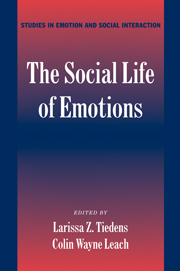Book contents
- Frontmatter
- Contents
- Acknowledgements
- List of Contributors
- The Social Life of Emotions
- Introduction: A World of Emotion
- PART I THE INTERPERSONAL CONTEXT
- 1 Empathy
- 2 Envy and Its Transmutations
- 3 The Bond Threat Sequence
- 4 Emotion as Adaptive Interpersonal Communication
- 5 Does Expressing Emotion Promote Well-Being? It Depends on Relationship Context
- PART II THE INTRAGROUP CONTEXT
- PART III THE INTERGROUP CONTEXT
- Index
- References
2 - Envy and Its Transmutations
Published online by Cambridge University Press: 01 April 2011
- Frontmatter
- Contents
- Acknowledgements
- List of Contributors
- The Social Life of Emotions
- Introduction: A World of Emotion
- PART I THE INTERPERSONAL CONTEXT
- 1 Empathy
- 2 Envy and Its Transmutations
- 3 The Bond Threat Sequence
- 4 Emotion as Adaptive Interpersonal Communication
- 5 Does Expressing Emotion Promote Well-Being? It Depends on Relationship Context
- PART II THE INTRAGROUP CONTEXT
- PART III THE INTERGROUP CONTEXT
- Index
- References
Summary
A routine fact of life is that we often meet people who are superior to us in some way. When their superiority matters to us, we can feel envy. Here is Shakespeare's Cassius, a literary prototype of the envying person, as he protests the honors being heaped on Caesar:
Why, man, he doth bestride the narrow world
Like a Colossus, and we petty men
Walk under his huge legs and peep about
To find ourselves dishonorable graves.
(Shakespeare, 1599/1934, p. 41)These words show an important quality of envy. The envying person notices another's advantage or superiority and feels inferior. Caesar was an exceptional man who had achieved military and political greatness, and Cassius felt undersized and trivial next to his grand presence. Envy begins with an unflattering social comparison resulting in a quick, painful perception of inferiority (e.g., Foster, 1972; Parrott, 1991; Salovey & Rodin, 1984; Silver & Sabini, 1978; Smith, 1991; Smith et al., 1999).
It is worth dwelling on why an unflattering social comparison might catch our attention and then create a painful emotion such as envy. From an evolutionary point of view, it is highly adaptive for people to have an inclination to scan their environment for threats of all kinds. In terms of potential threats from others, this also means that people should have the capacity and the inclination to assess their rank (e.g., Beach & Tesser, 2000; Buunk & Ybema, 1997; Frank, 1999; Gilbert, 1992; Smith, 2000).
- Type
- Chapter
- Information
- The Social Life of Emotions , pp. 43 - 63Publisher: Cambridge University PressPrint publication year: 2004
References
- 42
- Cited by



